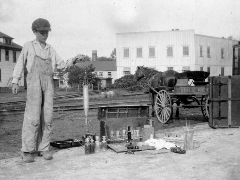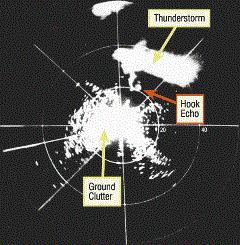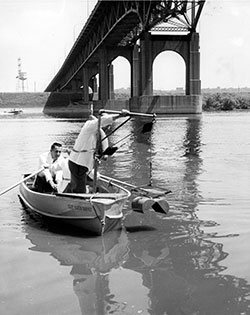For 130 years, the Illinois State Water Survey (ISWS) has been a leader in the study of water resources, weather, and climate.
1876 — Morrow Plots Weather Station is established. The Morrow Plots are the oldest continuous agricultural experiment field in the United States.
1895 — The Water Survey traces its start back to 1895 when the Illinois legislature appropriated $5,000 to the University of Illinois, earmarking $4,000 to study the state's water supply. In 1897, An Act to Establish a Chemical Survey of the Waters of the State of Illinois appropriated an additional $3,000. It directed a “chemical and biological survey of the waters of the State.” Arthur Palmer was the founder.
1905 — Dr. Edward Bartow was appointed the director of the Water Survey and began his tenure as an associate professor of sanitary chemistry at the University of Illinois.
1909 — Wilfred Langelier joined the Water Survey as a chemist. He went on to develop the Langelier Saturation Index, a tool to assess water’s corrosive or scale-forming potential.
 1910 — The
Water Survey’s original mission was to trace the spread of waterborne diseases, particularly typhoid fever. Typhoid was a particular problem in rural southern Illinois, but Chicago also had a high rate of the disease. By 1910, Water Survey staff
had tested more than 21,000 water samples from 971 towns in the state’s 102 counties. Many wells were condemned due to combinations of high levels of bacteria and minerals.
1910 — The
Water Survey’s original mission was to trace the spread of waterborne diseases, particularly typhoid fever. Typhoid was a particular problem in rural southern Illinois, but Chicago also had a high rate of the disease. By 1910, Water Survey staff
had tested more than 21,000 water samples from 971 towns in the state’s 102 counties. Many wells were condemned due to combinations of high levels of bacteria and minerals.
— The city of Lake Forest, Illinois, developed a wastewater treatment plant with a septic tank and filter field along the shoreline of Lake Michigan. The Water Survey maintains historical documents and images related to this facility, highlighting its role in early wastewater treatment efforts in Illinois.
1914 — The Water Survey inspected the Illinois State Fairground wells and found contamination, recommending their closure and a switch to Springfield’s public water supply. ISWS participated in the Illinois State Fair with an educational exhibit featuring a map of unsafe water sources, a contamination flow model, and model sanitary privies to promote safe drinking water practices.
1916 — The Water Survey investigated and ruled out the public water supply as the source of a typhoid fever outbreak in Pana, Illinois. Instead, it identified the Pana Ice Cream Company as the culprit due to contaminated milk containers.
1917 — The Water Survey (along with the Natural History Survey and Geological Survey) was transferred to the Illinois Department of Registration and Education.
1918 — Minna Ernestine Jewell worked at the Water Survey, conducting significant research on water quality in Illinois streams, including the Sangamon River.
1930s — The Dust Bowl Decade resulted in a shortage of surface and groundwater supplies in many parts of the state. The Water Survey was instrumental in advising local municipalities and water resource professionals on management strategies, publishing the state’s first inventory of municipal groundwater supplies. ISWS staff also conducted a sediment survey of Lake Decatur (the first such survey ever made by a state agency).
1931 — The Water Survey compiled a photo catalog of contractors repairing wells in Illinois, including 27 photos of water well contractors from central to northern Illinois.
1933 — During the Great Depression, the Water Survey undertook a project under the Civil Works Administration (CWA) to expand the understanding of Illinois waters. Over 3.5 months, the ISWS added 48,900 well records and analyzed approximately 1,250 water samples, culminating in the publication of "A Survey of the Ground-water Resources of Illinois."
1934 — Water Survey staff invented the “Down-Hole Camera” to view the interior of a well at the University of Illinois.
1948 — Water Survey meteorologists Glenn Stout and Floyd Huff collaborated with the Pfister Hybrid Corn Company in El Paso, Illinois, to study the feasibility of inducing rain using dry ice dispersed from an aircraft. They also evaluated, for the first time in Illinois, the effectiveness of radar equipment for precipitation studies.
1949 — A water treatment advisory service for state institutions began, saving the state thousands of dollars annually by recommending water heating and cooling systems treatments.
1951 — The Water Survey hosted an international water resources conference at the University of Illinois Urbana-Champaign, attended by over 230 scientists.
 1953 — On April 9, 1953, ISWS radar operators tested radar equipment to measure rainfall rates. The radar showed a sizeable hook-shaped echo emerging as they focused on a large thunderstorm passing north of Champaign. A hook echo is a classic sign of tornado development, and in this case, it turned out to be the funnel of a large, developing tornado that moved 54 miles to the east. This was the first time in the U.S. that radar detected and photographed a tornado.
1953 — On April 9, 1953, ISWS radar operators tested radar equipment to measure rainfall rates. The radar showed a sizeable hook-shaped echo emerging as they focused on a large thunderstorm passing north of Champaign. A hook echo is a classic sign of tornado development, and in this case, it turned out to be the funnel of a large, developing tornado that moved 54 miles to the east. This was the first time in the U.S. that radar detected and photographed a tornado.
 1954 — The
U.S. Weather Bureau established a "state climatologist" in each state to help state agencies and university scientists with climate data and information. Today, the office of the Illinois State Climatologist provides weather and climate data, maps,
and information for Illinois farmers, government agencies and policymakers, and all citizens. It acts as the state’s authoritative spokesperson on climate science. The first Illinois State Climatologist was Paul Sutton. Stanley Changnon served
as state climatologist from 1972 to 1980, followed by Wayne Wendland from 1981 to 1996. Jim Angel was the longest-serving state climatologist, filling the role from 1996 to 2018. Current Illinois State Climatologist Trent Ford took on the position in 2019.
1954 — The
U.S. Weather Bureau established a "state climatologist" in each state to help state agencies and university scientists with climate data and information. Today, the office of the Illinois State Climatologist provides weather and climate data, maps,
and information for Illinois farmers, government agencies and policymakers, and all citizens. It acts as the state’s authoritative spokesperson on climate science. The first Illinois State Climatologist was Paul Sutton. Stanley Changnon served
as state climatologist from 1972 to 1980, followed by Wayne Wendland from 1981 to 1996. Jim Angel was the longest-serving state climatologist, filling the role from 1996 to 2018. Current Illinois State Climatologist Trent Ford took on the position in 2019.
1956 — Civil engineer William C. Ackermann was appointed to lead the Water Survey.
1960s—The Water Survey designed and built two unique radars, the CHILL and the HOT, which enhanced capabilities in detecting hailstones and measuring airborne particle velocities.
1960 — Thomas A. Prickett graduated from the University of Illinois with a Bachelor of Science in General Engineering and joined the Water Survey. He subsequently went on to co-author Hydrogeologic Electric Analog Computers (1963), publish a paper advancing electric analog groundwater modeling (1967), develop the Prickett-Lonnquist Aquifer Simulation Model (PLASM) (1971), leave ISWS to join Camp Dresser McKee (CDM) (1977), and later establish his consulting firm, Thomas A. Prickett and Associates (1981), where he published The Random Walk Model for solute transport simulation.
1963 — William Walton and Thomas Prickett constructed electric analog groundwater models. In these models, the flow of electricity through an intricate network of wires, resistors, and capacitors represents water flow through porous geological formations with varying hydraulic properties. In the early 80s, their 1963 publication on this work in the Proceedings of the American Society of Civil Engineers was selected as a benchmark contribution to classic literature in the field of hydrogeology.
 1963-1965 — In 1963, ISWS director Ackermann went on leave
from the survey to serve as a water resources adviser to the Office of the President, working with federal agencies to create the federal government’s first coordinated water research plan. In 1965, Illinois Gov. Otto Kerner made Ackermann
the leader of a task force to develop a comprehensive state plan for water resources. The plan was released in 1965, but because of budget constraints, it was not implemented.
1963-1965 — In 1963, ISWS director Ackermann went on leave
from the survey to serve as a water resources adviser to the Office of the President, working with federal agencies to create the federal government’s first coordinated water research plan. In 1965, Illinois Gov. Otto Kerner made Ackermann
the leader of a task force to develop a comprehensive state plan for water resources. The plan was released in 1965, but because of budget constraints, it was not implemented.
1968 — The Water Survey designed and developed the nation’s first Doppler weather radar. It detected the motion of drops and particles inside a storm so that the formation of tornado funnels aloft could be spotted. The U.S. now has a network of Doppler radars for detecting and tracking tornadoes.
— The Morrow Plots are designated a National Historic Landmark.
1970 — Scientists devised and tested a unique approach to measuring crop hail losses from aircraft. Findings showed that infrared sensing allows quantification of hail damage. Subsequently, the insurance industry adopted this technique for national use.
1971 — Tom Prickett and C.G. Lonnquist developed the Prickett-Lonnquist Aquifer Simulation Model (PLASM), the first digital groundwater flow model. Prickett’s work in finite difference groundwater models set the stage for developing the now-standards USGS MODFLOW model in the 1980s.
1980s-1990s — Water Survey atmospheric scientists conducted pioneering studies of historic hail data and launched several field projects in Illinois to measure hail and its impacts on crops and property. During this era, the Water Survey also launched the nation’s first program to define the environmental and socioeconomic effects of weather and climate conditions, information valuable for estimating the impacts of possible future climate changes.
1981 — Stanley A. Changnon Jr. became Chief of the Water Survey.
1989 — Initiation of a three-year research project funded by the U.S. Department of Agriculture. The principal investigators were Steve Hollinger from the Water Survey, Michael Irwin from the Illinois Natural History Survey, and Scott Isard from the University of Illinois.
1990 — The Water Survey weather-radar program concluded, having achieved its research objectives.
1995 — Following a significant heat wave in Illinois with record-high numbers of deaths in the Chicago area, scientists conducted atmospheric studies to interpret the event’s climatic severity. The results guided revisions to Chicago’s policies for handling heat waves.
2007 — Water Survey scientists Stanley Changnon and Kenneth Kunkel shared the 2007 Nobel Peace Prize with other contributors through their work with the Intergovernmental Panel on Climate Change. The scientists served as authors, reviewers, or contributors to a series of reports assessing the state of science and the impacts of global climate change.
2008 — The University of Illinois Scientific Surveys Act transferred the Water Survey from the Illinois Department of Natural Resources to the newly established Prairie Research Institute at the University of Illinois Urbana-Champaign, bringing it back to its original home.
2012 — Jim Angel, a former Illinois State Climatologist, and Lauren Graham, a University of Illinois graduate, retrieved original handwritten weather records from the Rock Island Arsenal Museum and analyzed their accuracy, providing insights into early 19th-century weather patterns in Illinois.
 2013 — An amendment to the State Surveys Act created the State Hydrologist position. ISWS director Misganaw Demissie was the first to fill the role, serving until his retirement in 2016. Current
State Hydrologist Laura Keefer was appointed in 2018. The Illinois State Hydrologist provides science-based information on watersheds, rivers, groundwater,
and other state water resources and leverages the expertise of PRI staff on statewide water issues, such as flooding and contamination.
2013 — An amendment to the State Surveys Act created the State Hydrologist position. ISWS director Misganaw Demissie was the first to fill the role, serving until his retirement in 2016. Current
State Hydrologist Laura Keefer was appointed in 2018. The Illinois State Hydrologist provides science-based information on watersheds, rivers, groundwater,
and other state water resources and leverages the expertise of PRI staff on statewide water issues, such as flooding and contamination.
2017 — Kevin C OBrien was appointed to lead the Water Survey. OBrien is also the director of the Illinois Sustainable Technology Center.
2021 — The Water Survey showcased its historical research on sanitation, waterborne diseases, and wastewater treatment at WEFTEC in Chicago, presenting six themed posters featuring early 20th-century glass media.
2022 — Building on the previous year's success, the Water Survey was invited to exhibit again at WEFTEC 2022, held at the New Orleans Convention Center from October 10-12.
2023 — Laura Keefer was named Deputy Director of the Water Survey.
Learn more about the history of the Illinois State Water Survey on our blog.